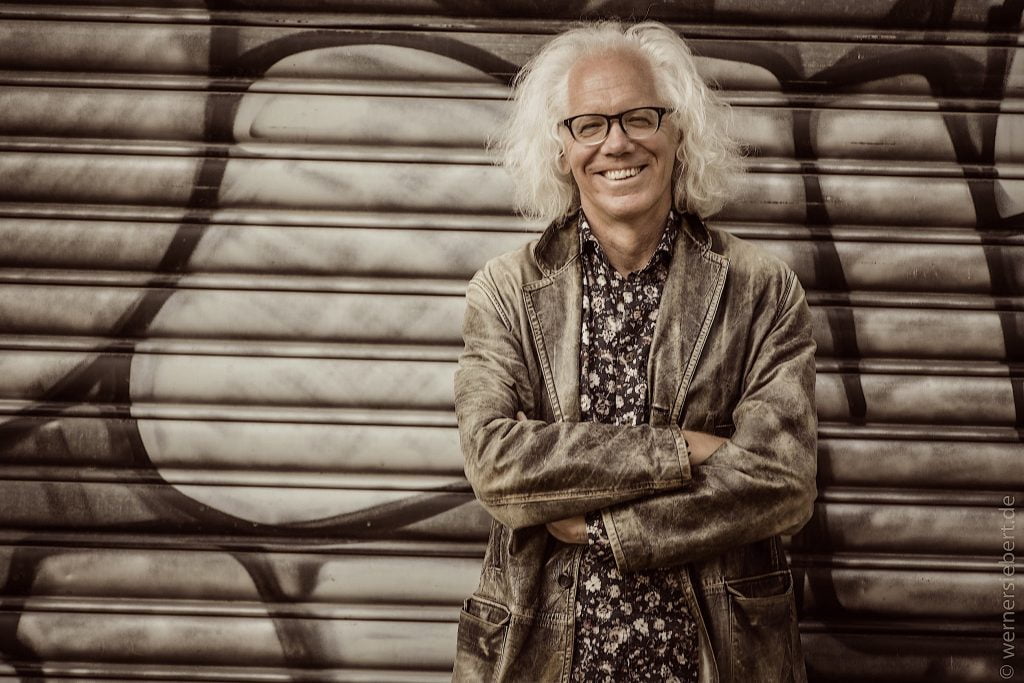Gunnar Geisse (born July 11, 1962 in Giessen). German Musician, improviser, composer and performer. He moves in the field of tension between experimental / improvised music and new music. For this he developed a complex set of instruments consisting of electric guitar and electronic sound processing, which he laptop guitar names. He also plays various other string instruments, in addition to the banjo and mandolin, primarily those from Central Asia, such as the Uzbek or Persian dotâr.
Geisse began his musical career as a rock guitarist in his early youth. At the end of school he switched to jazz and then completed an apprenticeship as an electric guitarist. When he attended a concert at the Moers Festival, he saw Ornette Coleman being carried onto the stage in a coffin and playing the free jazz he had influenced in a glittering disco suit. After this pivotal experience, Geisse bought plastic toy saxophones for his band members and abandoned the original plan of playing classical jazz standards. Improvisation and an experimental approach were anchored in his musical understanding during this time. However, his first professional engagement was with the New York Broadway Ensemble, with whom he toured Europe for about two years. Being part of an orchestral ensemble was the essential experience for him.
The avant-garde combo "Brother Virus" with Werner Klausnitzer, Patrick Scales and Maurice de Martin had a decisive influence on Geisse in the late 1980s. They made guest appearances in New York (Knitting Factory) and were the first band to play improvised music live on German television for a TV show – “Veranda” by Dagobert Lindlau. With "Brother Virus" Gunnar Geisse for the first time trod his own musical paths that had already become apparent in his development in previous years. The album "Happy Hour" was released by Enja in 1991.
In 1992 Geisse lost the two middle fingers of his right hand in a serious climbing accident. During the multiple stays in the hospital, it was initially not clear whether he would be able to continue his musical career. In dealing with the compositional techniques of the 20th century, he found his interest in structure. While still in the hospital, he wrote down his first compositions that can be more ascribed to New Music. In order to understand them aurally, he later recorded the individual tracks – up to 200 one on top of the other – in a recording studio. Out of his interest in structure, he worked together with the Institute for Experimental Physics at the University of Magdeburg in the fields of complexity theory, nonlinear phenomena and simulation and incorporated structural models of nature into his music. The recordings were published under the title "AtEM".
As part of a composition competition, Hans Zender became aware of this extraordinary music as a juror. Gunnar Geisse received a one-year scholarship from the Akademie Schloss Solitude. There the composition "The Discrete Now" was created. He immersed himself in the phenomenon of musical time. In the renewed search for possible structural specifications of nature, he received important suggestions and impulses at the Institute for Medical Psychology at the Ludwig Maximilian University in Munich (LMU) on the subject of "Time and its perception". The classic design parameters of tempo, meter and rhythm receded into the background as a result of this broadening of perspective in favor of a psychological perception of time.
After working on structure and time, Gunnar Geisse was faced with the question of an elementary approach to harmonics. Since 2003 he has been exploring the non-linear phenomenon of combination tones which arise in the cochlea of the inner ear without being physically present in the air space. As the missing building block for the elements already used, the partial tone series and partial tone matrix, the combination tones completed his harmonic compositional instruments to form an independent compositional technique. The works have been released on CD under the title "MEtA" by Creative Sources Recordings. In 2006 he gave insight into his specific harmonics through a theoretical script.
Paradoxically, with these compositional tonal precisions, noise-based improvisation and its physical, expressive moment became increasingly important for him; his improvisational models changed under these influences. From 2005, electronics and laptops increasingly became work and expression tools. In this context he developed his own hardware/software circuit (laptop guitar) which enables him to continue his analogue playing style on a digital level.
Gunnar Geisse has received several awards and grants, including the music promotion award of the City of Munich and the composition grant from the Akademie Schloss Solitude, Stuttgart. He has lived in Munich since 1985.
Gunnar Geisse played with many musicians from the three main areas of his musical work - experimental/improvised music, new music and contemporary jazz.
He has played with Richard Barrett, Phil Durrant, eRikm, Pierre Favre, Vinko Globokar, Barry Guy, Franz Hautzinger, Jason Kahn, Joëlle Léandre, Thomas Lehn, Michael Lentz, George Lewis, David Moss, Günter Müller, Olga Neuwirth, Phill Niblock, Evan Parker, Elliott Sharp, Giancarlo Schiaffini, Ed Schuller, Mike Svoboda, Gary Thomas, Wu Wei, Maurice de Martin, and Xu Fengxia.
Gunnar Geisse worked for / played works by Hans-Jürgen von Bose, John Cage, Peter Maxwell Davies, Fred Frith, Gérard Grisey, Hans Werner Henze, Tom Johnson, Helmut Lachenmann, Anestis Logothetis, Chico Mello, Josef Anton Riedl, Iris ter Schiphorst , Dieter Schnebel, James Tenney, Kurt Weill, Jörg Widmann, Christian Wolff and Udo Zimmermann.
He played - also as a soloist - under Stefan Asbury, Paul Daniel, Péter Eötvös, Franck Ollu, Lothar Zagrosek with the Bavarian Radio Symphony Orchestra (BR), the Bavarian State Opera Orchestra, the Stuttgart Radio Symphony Orchestra of the SWR, the Stuttgart State Orchestra, the orchestra of the Staatstheater am Gärtnerplatz in Munich and the Munich Symphony Orchestra.
Geisse was/is also a member of the bands Brother Virus, le petit chien, ICI ensemble, Go Guitars, Berlin Jazz Composers Ensemble, Fractal Gumbo, NIE Quartet.


